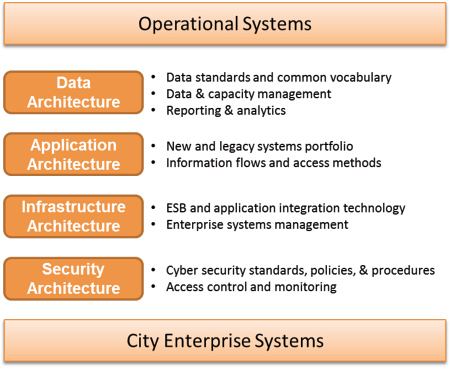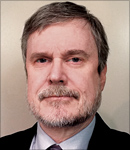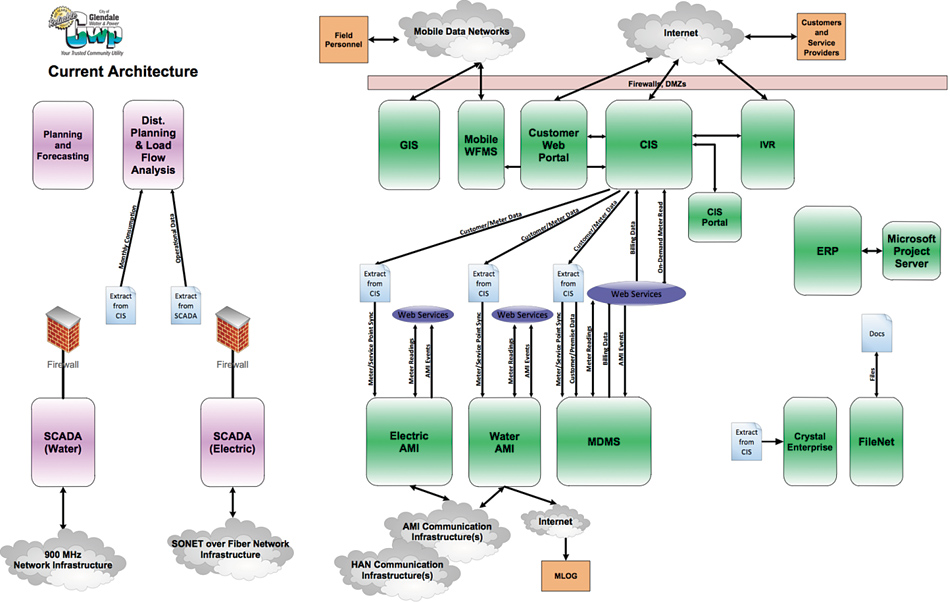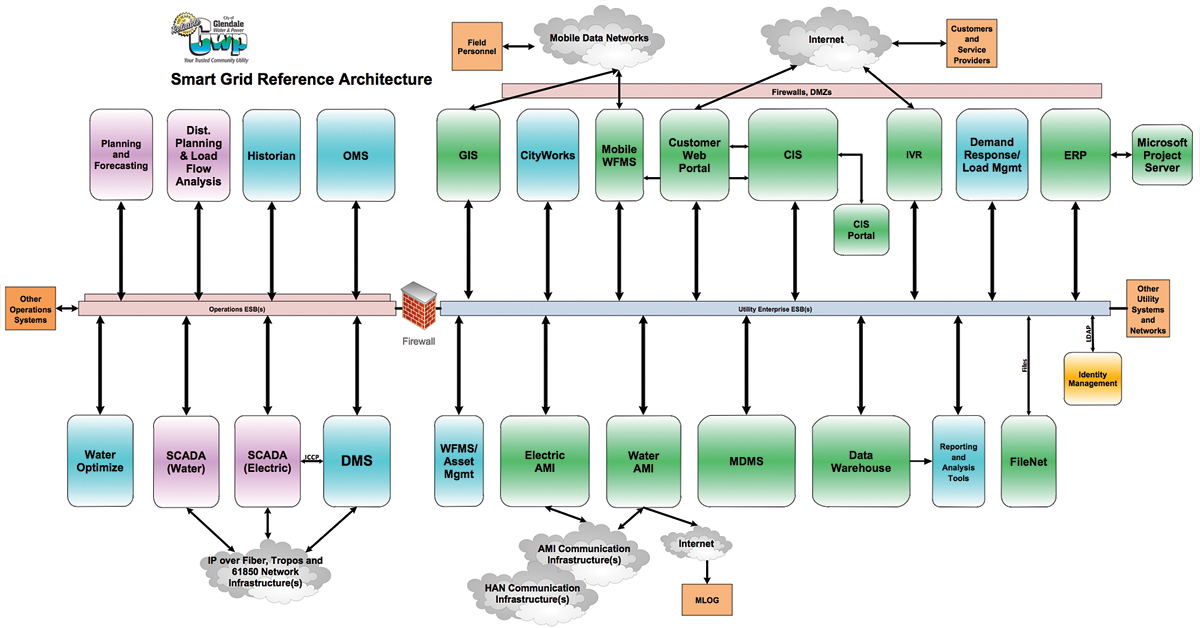Municipal utilities – or ‘Munis’ as they are often called – are the hometown power provider for more than two thousand communities across America. They are the personal face of energy to the 46 million people to whom they deliver not only electricity but often the gas, clean water, and wastewater infrastructure – the very underpinnings for public safety and economic prosperity for entire regions. As community-owned resources, MUNI interests are closely tied to the consumers they serve. Today, and over the next two decades as utilities update aging infrastructure with Smart Grid applications, municipal utilities face uniquely complex integration challenges and opportunities.
The Muni Smart Grid Premise
When a municipal utility deploys advanced metering infrastructure (AMI), adds two-way communications devices to its T&D resources, or incorporates renewable resources onto its power grid, it is likely to generate exponentially greater volumes of data. Likewise, every Smart Grid application tends to trigger new needs for managing and sharing information. Smart grid innovations bring complexity to any type of utility, but particularly for munis. For the muni -– often tasked with providing multiple services to diverse users across a community with a generally small in-house staff -- the resulting architectural complexity can be tremendous.
However, the potential gains for munis are great, too. Municipal utilities may be smaller in size and capability than their larger IOU counter parts, but they often also have relatively short infrastructure deployment cycles; small, lean IT departments; and more extensive application of standards. Municipalities are well placed to unlock additional opportunities by leveraging their technology investments across their communities. For example, munis have greater opportunities to integrate city-wide services which historically may have resided in departmental silos. In fact, munis, by the very nature of their mission and role in their communities, may be better positioned than any other utility type to readily enable the truly integrated “Smart City.”
Glendale’s Smart Grid Vision
From a national perspective, Glendale Water and Power (GWP) is a medium-sized municipal utility. It is owned and operated by the City of Glendale, the third largest municipality in Los Angeles County, which provides municipal utility and public works services to 200,000 residents. GWP manages a service territory with 71,000 residential and 12,000 commercial and industrial electric customers. GWP also manages about 29,000 residential and 4,000 commercial and industrial water customers.
The City of Glendale was the first ARRA Smart Grid Investment Grant (SGIG) recipient in the nation to sign a contract with the Department of Energy and is currently implementing Smart Grid technology and business processes to transform utility operational efficiency and sustain strong customer satisfaction. GWP recently completed the implementation of a new Advanced Metering Infrastructure (AMI) project as well as beginning to implement new distribution monitoring and control systems for power and water. These implementations represent enterprise data management systems that will significantly enhance Glendale’s capability to interact with its water and power customers.
Smart City Starting Point
Glendale’s technology started in a position that is common among municipalities. Originally, the structure was one of departmental silos and manual processes. Basic utility operations were achieved through applications that were not integrated to support process automation. Employees had little access to information from other operational areas. The infrastructure and application portfolio was managed by the individual departmental organizations with little city-wide consistency or standardization. Overall, GWP’s operational systems were both deployed and managed outside of the centralized city IT department. The following diagram depicts the architectural starting point for Glendale’s path to Smart Grid integration. City enterprise back-office systems (on the right) were isolated both physically and logically from the operational systems (on the left).
Integration Comes to Main Street
Depicting existing architecture is an essential step toward Smart Grid integration. It helps ensure that all city services are included in the overall effort. Early in the Smart Grid movement, the application of architecture as a discipline to systems integration was considered something only larger organizations with sizeable IT resources could consider. However, advances in data standards and systems integration platforms can now provide municipal utilities with a solid foundation upon which to integrate Smart Grid applications in a more effective and efficient manner than ever before. To achieve this vision, a municipal utility’s management must maintain an open view and willingness to consider alternative approaches. Fortunately, these qualities tend to be found readily in the smaller, more collaborative municipal enterprises.
As at many munis, staff in GWP’s operational departments felt the city’s IT department lacked the level of understanding and responsiveness needed to address the mission critical support needs of real-time operational systems that manage the electric and water distribution network. This perception drove operational departments to provide their own applications support outside of the city IT control. This siloed IT/OT arrangement is common throughout the utility industry and, historically, was considered adequate. However, the need to replace, upgrade, implement and integrate smarter utility applications requires the sharing of data across silos. It needs highly integrated systems that go beyond the basic support capabilities of the operational areas.
As each department began to orient itself around Smart Grid and began defining information system projects, city IT staff quickly realized that the overall program and infusion of SGIG funds meant that they would need to implement or enhance at least ten new enterprise-class utility applications. These applications would include:
- automated metering,
- outage and distribution management,
- workforce and asset management, and
- demand response.
In addition, it would require building more than 60 new interfaces between these new systems and existing legacy applications within a five-year window.
This program is a tall order even for the more capable and disciplined IOU’s, so how could it be implemented through the practices of the past and without a systematic approach to architecture? Would it require an army of IT resources and systems integrators that would quickly overwhelm both the internal staff and program budget? Was there, perhaps, a more tactful model that leveraged the existing organization and provided augmentation to key critical skill set areas?
Framework for a Smarter City
Although the primary source of funding for the program is the SGIG, budget approval processes needed to still flow through the city council. This requirement soon brought the IT department, a team that needed to understand complex information technology investments in order to appropriate funds, to the forefront of city management. Not only did this move present a set of challenges to the IT department to convey how such investments are needed in support of Smart Grid, but it also required the explanation of why the benefits of enterprise architecture and having a standard approach to application integration are foundational elements for a ‘Smart City’ framework with city-wide benefits potential. Although the new IT ‘assets’ are primarily for the operational departments, they essentially become shared, enterprise-wide utilities that present additional cost allocation challenges to ensure that the operations side is only funding its fair share.
GWP General Manager Glenn Steiger and City of Glendale IT Director Ed Fraga, both recognized the need for a comprehensive technical roadmap for the future integration of Smart Grid systems. They committed to mutual cooperation between the city and operations to ensure that the new technology investments would work together to provide city-wide benefits. They envisioned a roadmap to reflect the technology principle of implementing best-of-breed commercial, off-the-shelf software (COTS) and integrating standards rather than attempting to build custom application solutions. The principle of ‘buy and integrate’ vs. ‘develop and customize’ is much better suited for Glendale given the availability of technical resources on staff and the desired timeframe to implement the new systems. Accordingly, they decided to develop an architectural roadmap to achieve their objectives.
This roadmap, known as the GWP Smart Grid Architecture, is an overall guide for the acquisition and implementation of all systems and integrations. It is designed to ensure Glendale has a consistent, secure and reliable set of technologies and interactions. The advancements will make information available when and how it is needed by GWP operational and city enterprise systems, employees, customers and stakeholders. Both water and electric departments participated in developing the architecture as did City central IT to ensure that the architecture would bridge the current state of processes and systems to the future state of the integrated utility. The resulting architecture reflects both the business and technical needs of operations and the city by incorporating a broad set of requirements and addressing critical gaps in the current state.
The Enterprise Service Bus
Glendale’s Smart Grid architecture, in support of the Smart Grid and city-wide business strategy, is composed of four architectural domains - data, applications, infrastructure and security - and describes state-of-the-art technologies, processes, policies and standards. The Smart Grid Reference Solution Architecture, shown in the figure below, is a fully-integrated set of applications utilizing an Enterprise Service Bus (ESB) as a common integration platform foundational to the architecture.
ESB software connects applications and users via a set of standards and provides the interoperability that is essential to support and simplify complex application integrations. ESB software is vital to the integration architecture of GWP, which is based on a utility common information model standard data model, web services and a service-oriented architecture. The integration platform will be used to facilitate the exchange of information across various GWP operational and city enterprise applications; enabling more complex system, data and business process integration among a variety of legacy and new Smart Grid applications.
An ESB solution provides synergies by utilizing a common integration platform for the many applications. It reduces the overall number of application interfaces needed to be constructed, deployed and maintained for the Smart Grid program. Due to its sophistication, the adoption of an ESB platform was once considered beyond the capabilities of a municipal utility and reserved for large IOU class deployments. However, Glendale determined that the interoperability facilitated through the use of integration standards could actually provide more benefit to them as an organization. For example, the ESB eliminated the need to continually spend to support on extensive custom integration for point-to-point application interfaces for an increasing number of Smart Grid applications and systems.
The Transition Process
The City of Glendale is now transitioning from technology selection to the beginnings of concurrent implementations of various Smart Grid systems. GWP has successfully completed the installation of AMI for each of its electric and water customers. By using the Smart Grid Reference Solution Architecture as a planning tool, the city can ensure adherence to the architecture and fulfill the data access needs of each department.

This system often requires trade-offs, and at times, concessions to either avoid duplication of functionality by utilizing systems to serve common requirements or prevent the fall back position of silos in OT/IT. For example, one approach to asset management considers city-wide assets regardless of whether they are parts of the electric or water infrastructure. Glendale realized an immediate benefit of the new approach with a degree of coordination, cooperation and communication between the GWP and city departments, which was often tenuous prior to the adoption of the Smart Grid architecture. Other current phase activities include:
- Development of a common data model and standards for messaging, which are used to guide the acquisition and implementation of all systems. The city is establishing architectural guidelines for applications and databases to improve maintainability and reduce costs.
- The creation of an Information Technology Executive Board, with members of both IT and OT, to track and evaluate new technologies and systems and ensure alignment with standards and the overall architecture.
- Implementation of an Enterprise Service Bus (ESB) across all GWP and city applications to provide a shared integration platform and reduce ongoing integration and maintenance costs through standardization.
- Implementation of new and enhanced applications as planned including DMS, OMS, & Water SCADA, and Water Work Orders leveraging the established standards.
- Formalizing security policies and standards across GWP and city organization, including the establishment of a Security Architecture Review Team.
- Enabling an Organizational Change Management program that establish roles, responsibility and organization to best leverage the Smart Grid Architecture and realize benefits.
- Initiating a formal Program Management Office (PMO) framework and an approach to risks & dependencies management, change management, and overall project management.
Smart Benefits Reach Main Street
Beyond electric operations and customer services, other city services will benefit from the Smart Grid integration. The City of Glendale’s water, public works, police and fire services will be able to share data. The adoption of standard information models, including IEC1 CIM, is increasing interoperability among a highly heterogeneous application portfolio. In the future, the city will be able to manage the sharing of operational information with outside agencies. For example, future integration may include integration with the Department of Homeland Security’s UICDS2 standard, allowing for multi-jurisdictional emergency operations management and coordination. When the 21st Century integration of Homeland Security with local government services is practical, the City of Glendale will be among the few cities well positioned to realize the full benefits of that integration.
Through the combination of a pragmatic approach to enterprise architecture, a strategic acquisition of technology, a tactical augmentation on critical skill sets, and the adoption of a sustainable program governance framework, the City of Glendale is well on its way to meeting the Smart Grid challenge -- without the need for a large department of personnel or an army of contractors. Ultimately, Glendale’s foresight in making an enterprise-wide investment in systems integration technology, standards and new processes is laying the foundation for a Smart City, whose benefits extend in practical ways to all of its consumers on Main Street.
About the Authors

Edward Fraga

John Wambaugh

Joe Tellez
Edward Fraga is Director of Information Services for the City of Glendale Water and Power. John Wambaugh is senior vice president and Joe Tellez is vice president of Smart Grid Integration Consulting for UISOL (Utility Integration Solutions). The three have collaborated to design and deploy GWP’s Smart Grid architecture and to craft this article.
1 IEC – International Electrotechnical Commission
2 Unified Incident Command and Decision Support - standards based interoperability for emergency operations.









